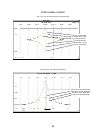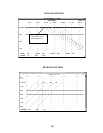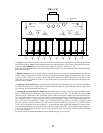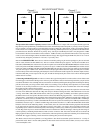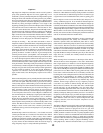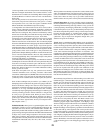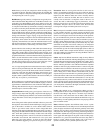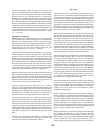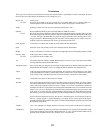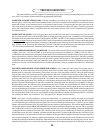
Loops: The trick? Make the bad stuff sound good and the good stuff
sound bad. Put it all together and go nuts with the mute switches. For
that ol’ telephone filter, first try the two mid bands with deep shelf
cuts. You might expect to just use the filters but these ones probably
neither go high enough nor low enough for this purpose so use them
in combination with those deep shelves.
Synths: There is a lot of room to EQ on analog synths and often less
with samplers. Watch out for sub-harmonics and ultra-deep lows
that the small monitors don’t reproduce. What you hear in the studio
and what “they” hear with a subwoofer can be different, and that is
often an understatement. Some car systems are a good place to
evaluate the very deep subwoofer zone.
More often than not, try to leave space for the rest of the tracks by
dipping a bell curve strategically. It works better than boosting bells
(into resonance) on the remaining tracks. If the arrangement is
dense, avoid making every sound as big as a house. The secret to
amazing sounding individual tracks are sparse sections where these
sounds are featured. The arrangement also helps create contrasts and
sets up the thicker sections to be huge. LP Filters can be very
interesting on synths because a LP filter sound is a functional part
of analog synth hardware (or software). Try making up a synth-like
resonant filter with one of the high shelves deeply cut and the
Bandwidth turned way up. Too bad you can’t sweep it.
Mixes: There are two ways to process a mix. The first is to set up the
2 mix EQ and compression early in the rough mix stage, then mix
into the processor. The second and more common way is to get a
finished mix then EQ and compress. The first way forces you to mix
differently and can produce results that can be powerful, but it can
also be dangerous in less than experienced hands. More and more
guys are EQing their final mixes. Sort-of pre-mastering or skipping
the mastering process altogether. Should you?
Let us describe some of the main ideas in mastering from the
mastering engineer’s “order of importance” and you can decide.
1) The most important thing in mastering chain is the mastering
engineer. These people EQ and compress, edit and check everyone’s
“final” mixes, a CD or two a day, 5 days a week, and year in and year
out. They specialize in the most subtle paths to the polished product.
They are expected to bring the clients tapes to be “ready for prime-
time” quality and be sure that a problem free master is absolutely
ready for any pressing plant. Of course, you are going to have to pay
for this “expert” service.
2) The most important piece of gear for mastering is the tweaked-up
speaker systems. The best mastering engineers typically spend a
great deal of money, time and effort to be sure that their room is true
and accurate (to them) and that every last bit of performance is
squeezed out of the entire system and that it is that way every day.
After all, the big reason we need to go through the mastering process
is that most of us mix on cheap, small speakers, self-powered or not.
The kinds of speakers most of us use for mixing are about 2%-25%
of the reference quality most mastering engineers use every day. If
you describe your monitors as “I guess the speakers are good enough
to master on” then they’re not and if you say “ I KNOW these
particular monitors in this room are good for mastering” then they
probably are. These may well be the same speakers too. Do you
understand the difference? (its not just attitude)
3) The rest of the gear in major mastering houses is also so important
that “cost is no object”. The engineers regularly “shoot-out” new
gear and will always buy if it IS better. In a pro mastering house there
are no weak links in the chain and no semi-pro gear.
4) There isn’t a single processing unit that is the key but more
like a combination of several that are mostly slightly utilized. A
common scenario is a combination of esoteric analog parametric
EQs and compressors along with the digital EQs and dynamics
processors, all used together and each for a few dB of its
strongest features. Manley Labs is one of the very few names
commonly seen in most major mastering facilities.
The newest and least common piece of gear in project level
mastering is “DSP Multi-band Compressors”. Multi-band
compressors have been used to maximize the loudness of radio
and network broadcasts for about 20 years. Do you really like the
radio squash? Contrary to the ads, a single piece of gear does not
make anybody into a mastering engineer. This also does not
mean these devices are bad, only that they can be somewhat
dangerous, or powerful and sometimes amazing when used
properly and carefully. Rather than think of them as multi-band
compressors, you will find that they act like multi-compressed
EQs. These compressors are changing the EQ all the time so it is
important to understand the specifics of the controls and what
each does to the sound. Just because it is multi-band doesn’t
excuse a poorly set-up compressor, in fact, it makes it worse
because EQ changes are easier to notice than “flat” gain changes.
The most exercised button should be the bypass switch. The
mastering engineer may not be able to fix up a tape butchered by
these toys. It is becoming a common story, where the mastering
engineer sends the client back to re-mix because of an abused
multi-band toy.
One can prepare for mastering, fairly simply. Mix to a well
maintained 1/2" tape or to a 20 or 24 bit digital format. Many
guys mix to DAT only, but mastering engineers will almost
always suggest analog. Best format - mix to all three and let the
mastering engineer choose. The best prep for the mastering
engineer is a well balanced mix. It's fine to compress and EQ the
mix, but absolutely don’t overdo it. Be careful, you can mess up
months of work if you get carried away. The time to de-ess is
during mix as the final step in the vocal chain. De-essing a mix in
mastering can be 10 times harder. You have probably heard that
one of the reasons we master, is to get hotter levels. True, but
keep in mind that anybody can compress 20 dB, squash and clip
and get super-loud but that mastering engineers do not do that.
The way they compress and limit typically gets about 6 dB into
the red on a VU meter and rarely sounds compressed or
crunched. It is not only about getting louder, but “optimally loud”
and not at all messed up in the process.
The best way to prepare for mastering is to do the best mix you
can. Don't go nuts on trying to pre-master, by over-compressing
and EQing and especially "multi-band limiting". The idea is to let
the mastering engineer do their job and not try to do it for them.
Leave them enough room to work and get
optimal compression.
The other thing to remember is to know the speakers you are
mixing on. An 8 inch woofer should not sound like an 18 incher.
The second most common problem is from engineers who have
cranked up their sub woofers and end up with a mix with no
bottom. Play other peoples great mixes on your speakers fairly
frequently. It helps maintain your reference.
23



